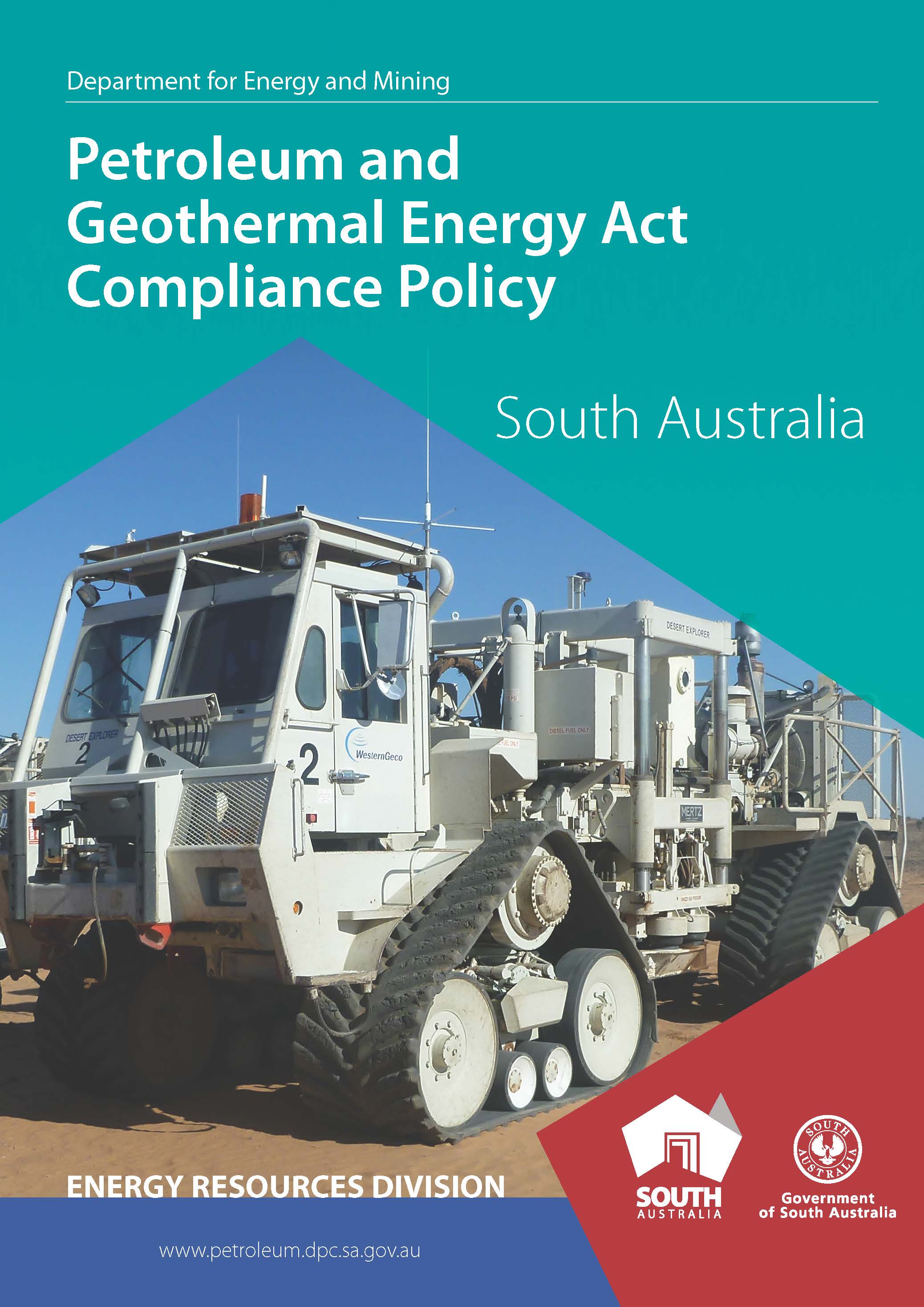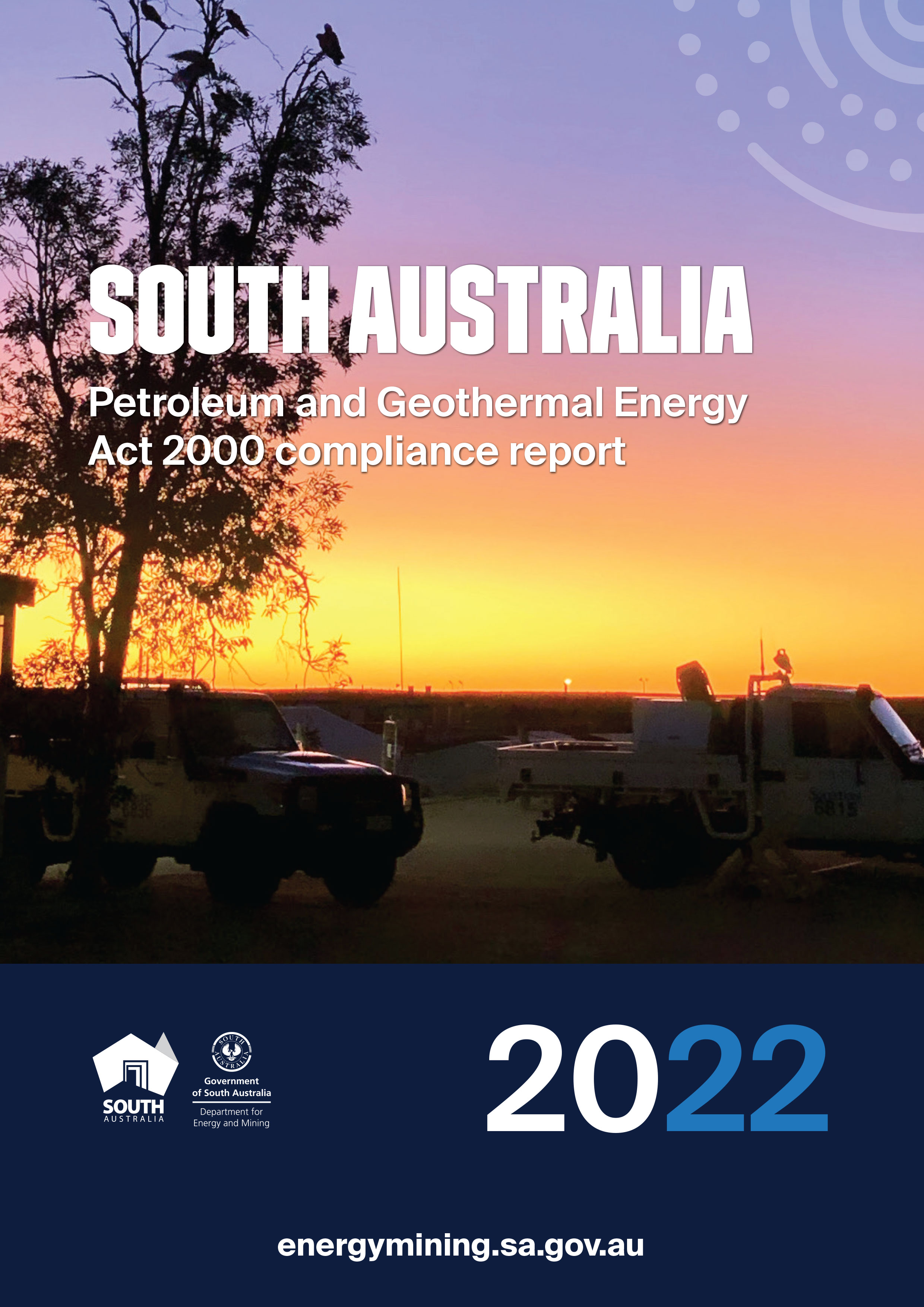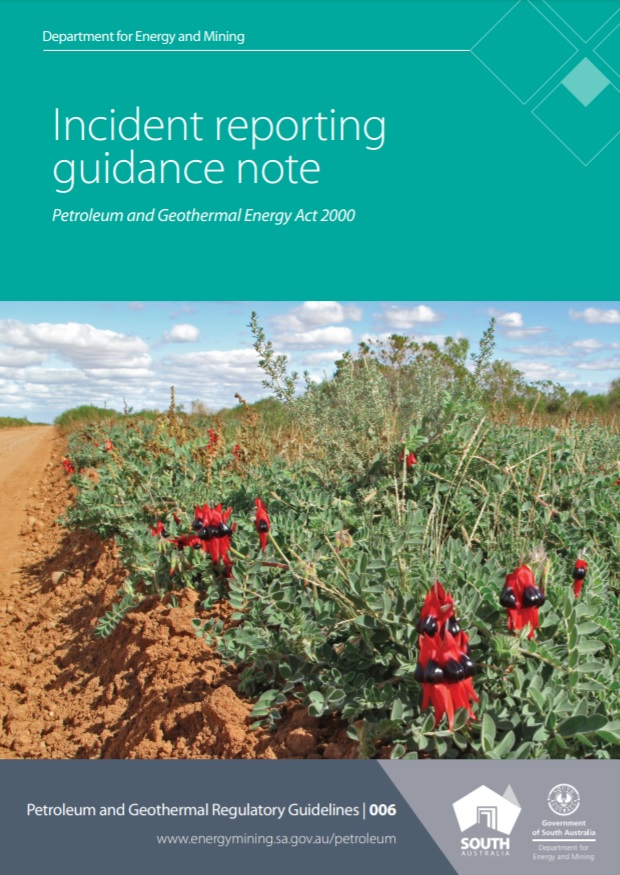Update 11 April 2024 – Legislation has been amended
Please refer to current legislation Energy Resources Act 2000 and Energy Resources Regulations 2013.
The amended legislation supersedes the Petroleum and Geothermal Act 2000 and Petroleum and Geothermal Energy Regulations 2013.
Guidelines and policies have yet to be reviewed in accord with the amended legislation, any updates of these documents will be advised accordingly.
For further information please contact DEM.Petroleum@sa.gov.au
On this page
Enforcement of compliance
The compliance and enforcement priorities of the Energy Resources Division are driven by the objectives of the The Petroleum and Geothermal Energy Act 2000. The key concept underlying the enforcement of the Act is that the basic responsibility for detecting and rectifying non-compliance lies with the licensee or individual, not the regulator. A range of enforcement tools are available to the Energy Resources Division for various key requirements of the Act, Regulations, licence conditions and Statement of Environmental Objectives, and are outlined in the Petroleum and Geothermal Energy Act Compliance Policy.
The Compliance Policy is grounded on the principle of an enforcement pyramid, shown in figure 1 below. The type of Enforcement action(s) taken by the Energy Resources Division depends on the seriousness and repetitiveness of the offence(s), in accordance with the policy.

Figure 1: Energy Resources Division compliance and enforcement pyramid
The pyramid details a series of steps and measures available to the Energy Resources Division for facilitating, monitoring and, where necessary, enforcing compliance. The Energy Resources Division aims to maintain its regulatory activities at ‘Step 1: Preventative measures’, shown as the base of the pyramid in Figure 1. In cases where industry fails to adequately and appropriately response to detected noncompliance, ‘Step 2: Persuasive measures’ is instigated. Only in extreme and exceptional cases would the Energy Resources Division expect to utilise Steps 3 and 4, ‘Compulsive’ and ‘Punitive’ measures, respectively, to enforce compliance and achieve acceptable environmental or administrative outcomes. Note, the Energy Resources Division contemplates the concurrent use of compliance measures.
Petroleum and Geothermal Energy Act annual compliance reports
Annual Petroleum and Geothermal Energy Act compliance reports are prepared by the Energy Resources Division for the purpose of:
- outlining the compliance monitoring and surveillance activities carried out by the Energy Resources Division during each year for activities regulated under the Petroleum and Geothermal Energy Act 2000; and
- providing an overview of the regulatory performance of the petroleum and geothermal industries in accordance with the requirements of the Petroleum and Geothermal Energy Act 2000.
The most recent Petroleum and Geothermal Energy Act compliance report is available to download:
Previously released compliance reports
- Compliance Report 2021 (PDF 5.7 MB)
- Compliance Report 2020 (PDF 5.5 MB)
- Compliance Report 2019 (PDF 2.3 MB)
- Compliance Report 2018 (PDF 2.6 MB)
- Compliance Report 2017 (PDF 3.1 MB)
- Compliance Report 2016 (PDF 5 MB)
- Compliance Report 2015 (PDF 3.6 MB)
- Compliance Report 2014 (PDF 4.4 MB)
- Compliance Report 2013 (PDF 3.7 MB)
- Compliance Report 2012 (PDF 2.9 MB)
- Compliance Report 2011 (PDF 2.2 MB)
- Compliance Report 2010 (PDF 2.1 MB)
- Compliance Report 2009 (PDF 2.3 MB)
- Compliance Report 2008 (PDF 753 KB)
- Compliance Report 2007 (PDF 584 KB)
- Compliance Report 2006 (PDF 464 KB)
These annual reports satisfy the requirement to publish information on authorised investigations carried out during the course of a year, as per Section 123 of the Petroleum and Geothermal Energy Act 2000.
Incident reporting
Under the Petroleum and Geothermal Energy Act 2000 and the Petroleum and Geothermal Energy Regulations 2013, incidents are classified into either Serious or Reportable.
A reportable incident is defined under the Act as an incident arising from activities conducted under a licence in which:
a) An escape of petroleum, a processed substance, a chemical or a fuel that affects an area that has not been specifically designed to contain such an escape;
b) An incident identified as a reportable incident under the relevant Statement of Environmental Objectives.
Regulation 32 outlines the requirements for reporting incidents to the Energy Resources Division. Reportable incidents are to be reported to the Energy Resources Division on a quarterly basis within 1 month after the end of each quarter.
Any serious incident must be reported to Energy Resources Division immediately and then followed up, within three months, by a detailed report explaining the root cause and corrective actions taken to prevent its recurrence. Furthermore the Act requires licensees to take appropriate action to ensure that any long-term damage is avoided (i.e. breach to relevant Statement of Environmental Objectives), and that adequate corrective action is taken to minimise the likelihood of the recurrence of such an incident.
A serious incident is defined under the Act as an incident arising from activities conducted under a licence in which:
a) A person is seriously injured or killed; or
b) An imminent risk to public health or safety arises; or
c) Serious environmental damage occurs or an imminent risk of serious environmental damage arises; or
d) Security of natural gas supply is prejudiced or an imminent risk of prejudice of natural gas supply arises.
Pursuant to Regulation 12, more specific definitions of events which constitute a serious incident under the broad definition in section 85 of the Petroleum and Geothermal Energy Act 2000 are provided in respective Statement of Environmental Objectives's.
To report a serious incident to DEM, as required by Section 85(2) of the Petroleum and Geothermal Energy Act 2000, licensees should contact the serious incident report hotline on: (08) 8463 6666. In the event the number is unattended, please record a message and DEM will return the call as soon as practicable.
Guidance documents
In accordance with good governance principles the Energy Resources Division has articulated its expectations for the various requirements under the Act and Regulations and to that end provides the following guidance documents:
| Incident Reporting Guidance Note - Petroleum and Geothermal Energy Act 2000 |
|---|
|
Company annual reports
Under Regulation 33 of the Petroleum and Geothermal Energy Regulations 2013, and to ensure the transparency and openness principles of the Petroleum and Geothermal Energy Act 2000 are applied in terms of the performance of the industry, licensees are required to report their level of compliance with the Act and any relevant statement of environmental objectives. The main purpose of this requirement is to ensure licensees assess and review their performance regularly, and through this process proactively take corrective actions where required to rectify any identified deficiencies, and improve their performance on continuous basis. Company annual reports are available on the annual reports page.
For some objectives, which cannot readily be measured through quantitative assessment, particularly in relation to land and vegetation disturbance such as the restoration of well sites and seismic lines, techniques such as Goal Attainment Scaling have been adopted to provide such measurement. Guidelines outlining this process are under Policies and Guidelines.
Process safety management framework
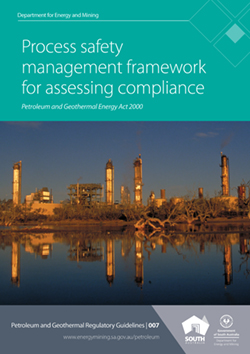
Of particular relevance to this process safety management framework and ERD’s assessments of compliance are submissions under:
- Regulation 16 (operator assessment factors): the adoption and implementation of an effective management system for identifying and maintaining effective controls for both the prevention of hazardous events and mitigation of the potential consequences of any such events.
- Regulation 30 (fitness-for-purpose assessments): the assessment of the fitness for purpose of the controls in place for both the prevention of hazardous events and mitigation of the potential consequences of any such events.
- Regulation 32 (incident reports): an assessment of the systemic causes resulting in the impairment of the controls in place, which have led to an incident.
Outcomes from these assessments and other sources inform ERD’s ongoing surveillance of regulated activities, for compliance with the Act, regulations, and relevant statement of environmental objectives.
Process safety and environmental management system
From 2006 to 2018, the Energy Resources Division encouraged Licensees to complete a Health, Safety and Environmental Management System self-assessment tool in alternate years. This exercise served a dual purpose of confirming and informing ERD’s surveillance plans and activities, and assisting Licensees to identify components of their management systems requiring improvements or enhancements to deliver greater overall system effectiveness. Furthermore, these assessments provided consistency and certainty in the process by which Licensees can achieve and maintain low level supervision (surveillance) status in accordance with Section 74 of the Petroleum and Geothermal Energy Act 2000.
In 2020, ERD completed a review of this tool to shift the focus to Process Safety and Environmental Management Systems, to better align with the objectives of the PGE Act and the SEO, and to reflect the change in focus in industry best practice. The 15 Elements that make up this new framework have been based on a selection of industry recognised process safety management frameworks, that were then mapped to the requirements of Regulation 16 Operator Assessment Factors. In particular, ERD have focused on the Energy Institute High Level Process Safety Management Framework (2010).
The intent is to provide a clear line of sight to between areas of focus for ERD’s surveillance activities and the requirements of the Regulations. This assessment framework focuses on 3 tiers as shown below:
- Tier 1: The Regulation 16 requirements;
- Tier 2: Industry recognised process safety and environmental management elements; and
- Tier 3: Company specific systems, policies, procedures and guidelines used to deliver the Tier 1 and 2 requirements
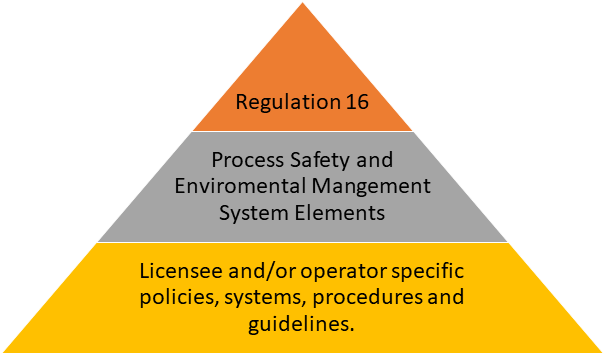
The objective of this framework is to assist Licensees and operators to self-assess the effectiveness and maturity of their management systems in delivering acceptable Process Safety and Environmental (PSE) performance, specifically in the context of the Petroleum and Geothermal Energy Act 2000 (the Act) and Regulation 16 – Operator Assessment Factors.
A guidance document is available with more information on the tool, and a proforma is available for use by both the Energy Resources Division and Licensees to complete the self-assessment process, and encourages assessors to accompany their scores with supportive comments where relevant.
Interpretation of the results, such as industry wide trends, strengths and weaknesses, will be published by ERD in our annual compliance reports. Individual results will not be published, nor any licensee specifically identified.
Fitness-for-purpose assessments
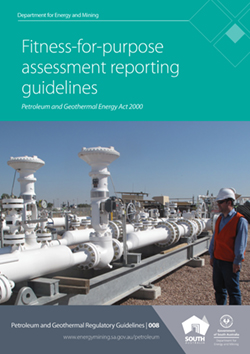
A report on the assessment must be prepared in accordance with Regulation 30 and submitted to the Energy Resources Division. The fitness-for-purpose assessment reporting guidelines PGRG 008 (PDF 262KB) outline the manner and form required for the FFP report, provide guidance to licensees on how the requirements of the regulations can be met, and include a fillable checklist that must be completed and submitted with the final FFP report.
Notices of availability for submitted fitness-for-purpose reports that may be provided upon request are listed on the Environmental Register.
Emergency response exercises
A key component of the preventative measures of the Energy Resources Division's compliance and monitoring strategy is to ensure appropriate plans are in place for emergency incidents. Under the Petroleum and Geothermal Energy Act 2000, measures must in particular focus on the prevention of environmental, public safety and security of gas supply incidents. Regulation 31, of the Petroleum and Geothermal Energy Regulations 2013, requires that licensees maintain effective response procedures to be followed in the event of such emergencies. It also requires that these procedures be tested for effectiveness by conducting a practice drill at least once every two years, with a report into the findings of the exercise prepared and provided to the Energy Resources Division. Emergency response exercises are summarised each year in the annual compliance reports.
High and low surveillance classification
Section 74 of the Petroleum and Geothermal Energy Act 2000 requires a mandatory licence condition which divides regulated activities carried out under a licence into those requiring 'high level surveillance' by the regulator and those requiring 'low level surveillance'.
Flexibility is one of the key regulatory principles of the Petroleum and Geothermal Energy Act 2000. The Energy Resources Division aims to ensure that the level of intervention needed to ensure compliance is appropriate to the specific company or individual being regulated and the outcomes that need to be achieved.
The degree of regulatory intervention for a specific activity will be dependent on the extent to which a licensee demonstrates its capability to achieve compliance with the Petroleum and Geothermal Energy Act 2000 and Statement of Environmental Objectives relevant to that activity, through implementation of effective management systems and processes, and past compliance record.
As a result of classifying activities to be conducted by each licensee as either low or high surveillance, the most cost effective level of regulatory scrutiny needed to ensure compliance can be selected. To reflect the lower level of surveillance and hence lower cost needed to ensure compliance of low surveillance activities, the Bill allows for up to 50% reduction on annual licence fees for such activities.
The key difference between a high and low surveillance operator is the extent of regulatory scrutiny given by the regulator in the approval process and the surveillance level of the activities undertaken by the licensees.
High surveillance activities
For high surveillance operators (predominately new entrants with no proven track record) the regulatory scrutiny is higher. Activities where a licensee cannot demonstrate a high level of compliance will be classified as high surveillance. For high surveillance activities in addition to establishing, monitoring and enforcing company performance against the environmental objectives, the regulator will also need to assess and monitor on an activity basis the likelihood of the licensee achieving the regulatory objectives and take the appropriate corrective action if required. Before being able to undertake activities, high surveillance licensees are required to provide a notice for activities, which is required to be approved by the Energy Resources Division, and must have work-programs formally approved.
Low surveillance activities
Activities for which a licensee demonstrates a high level compliance culture – ability to comply with regulation - will be classified as low surveillance. For these activities the regulatory role will basically involve establishing the environmental objective in consultation with other stake holders; monitoring the achievement of the objectives; facilitating reporting of company performance against those objectives to other stakeholders; and enforcement of company compliance when needed.
More information on the differing requirements of licensees to provide activity notifications can be found in the activity approvals process.
Determination of the level of surveillance
All licensee’s are initially high-level official surveillance operators for all activities, unless specifically classified as a low-level official surveillance operator for specific activities by the Minister.
To assess whether a licensee is able to be granted low level surveillance classification, the Energy Resources Division will consider a number of factors, including the operator assessment factors detailed under Regulation 16 of the Petroleum and Geothermal Energy Regulations 2013. These factors address a number of capabilities in terms of the licensee’s work practices, procedures, systems and resources for achieving compliance. Past demonstrated performance and history of compliance are also necessary for classification as low surveillance.
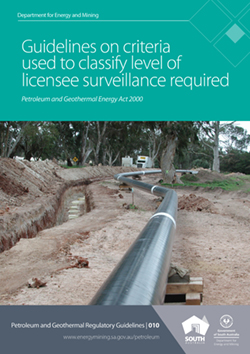
Energy Resources Division has prepared guidelines on criteria used to classify level of licensee surveillance required PGRG 010 (PDF 1.67MB) to provide guidance to licensees for the preparation of applications for low level official surveillance status and outline the criteria that will be used to assess a licensee’s operator assessment factors for this purpose, in line with section 74 and subregulation 17(1). This guideline is published as required by subregulation 17(2).


